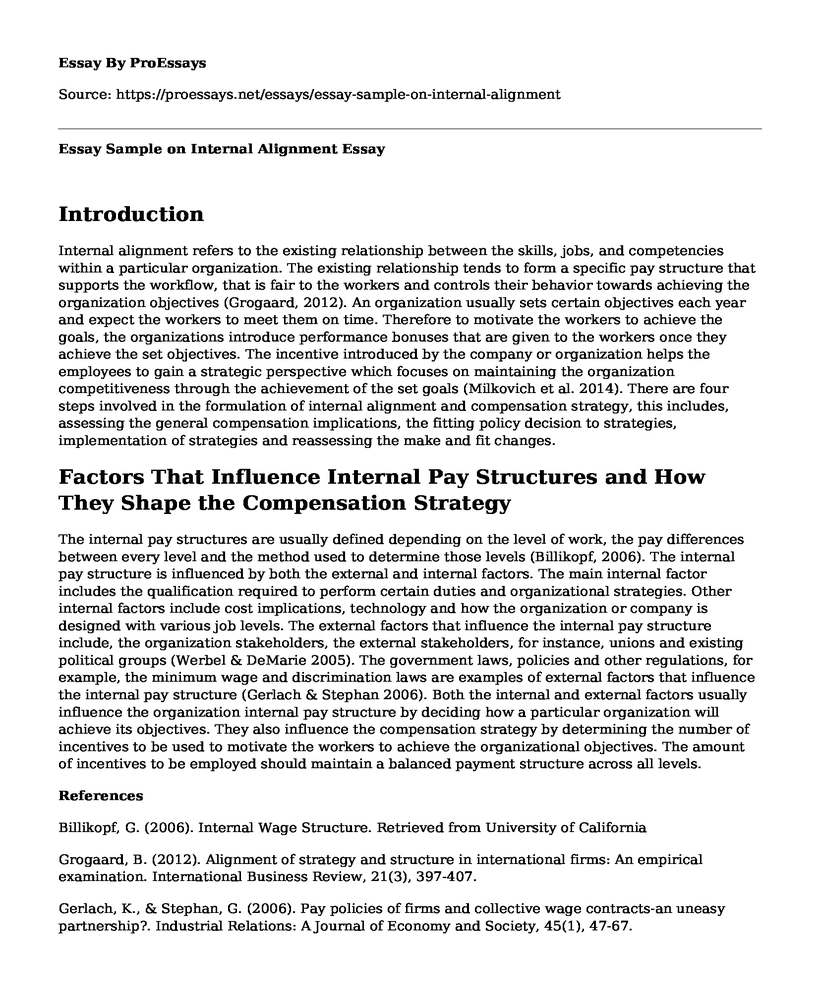Introduction
Internal alignment refers to the existing relationship between the skills, jobs, and competencies within a particular organization. The existing relationship tends to form a specific pay structure that supports the workflow, that is fair to the workers and controls their behavior towards achieving the organization objectives (Grogaard, 2012). An organization usually sets certain objectives each year and expect the workers to meet them on time. Therefore to motivate the workers to achieve the goals, the organizations introduce performance bonuses that are given to the workers once they achieve the set objectives. The incentive introduced by the company or organization helps the employees to gain a strategic perspective which focuses on maintaining the organization competitiveness through the achievement of the set goals (Milkovich et al. 2014). There are four steps involved in the formulation of internal alignment and compensation strategy, this includes, assessing the general compensation implications, the fitting policy decision to strategies, implementation of strategies and reassessing the make and fit changes.
Factors That Influence Internal Pay Structures and How They Shape the Compensation Strategy
The internal pay structures are usually defined depending on the level of work, the pay differences between every level and the method used to determine those levels (Billikopf, 2006). The internal pay structure is influenced by both the external and internal factors. The main internal factor includes the qualification required to perform certain duties and organizational strategies. Other internal factors include cost implications, technology and how the organization or company is designed with various job levels. The external factors that influence the internal pay structure include, the organization stakeholders, the external stakeholders, for instance, unions and existing political groups (Werbel & DeMarie 2005). The government laws, policies and other regulations, for example, the minimum wage and discrimination laws are examples of external factors that influence the internal pay structure (Gerlach & Stephan 2006). Both the internal and external factors usually influence the organization internal pay structure by deciding how a particular organization will achieve its objectives. They also influence the compensation strategy by determining the number of incentives to be used to motivate the workers to achieve the organizational objectives. The amount of incentives to be employed should maintain a balanced payment structure across all levels.
References
Billikopf, G. (2006). Internal Wage Structure. Retrieved from University of California
Grogaard, B. (2012). Alignment of strategy and structure in international firms: An empirical examination. International Business Review, 21(3), 397-407.
Gerlach, K., & Stephan, G. (2006). Pay policies of firms and collective wage contracts-an uneasy partnership?. Industrial Relations: A Journal of Economy and Society, 45(1), 47-67.
Milkovich, G. T., & Newman, J. M. Gerhart. B.(2014). Compensation.
Werbel, J. D., & DeMarie, S. M. (2005). Aligning strategic human resource management and person-environment fit. Human Resource Management Review, 15(4), 247-262.
Cite this page
Essay Sample on Internal Alignment. (2022, Nov 13). Retrieved from https://proessays.net/essays/essay-sample-on-internal-alignment
If you are the original author of this essay and no longer wish to have it published on the ProEssays website, please click below to request its removal:
- Essay Sample on Chrysler Bailout Decision
- Competent Organizational Leadership of Coca-Cola Company
- Is Luxury Kids Market a Way of Diversification of Luxury Brands?
- Electronic Commerce Project for Technojob Paper Example
- Essay Sample on Supply Chain Planning: Push vs. Pull Systems
- Disruptive Tech: How It's Transforming Organizations & Consumers - Essay Sample
- Kia Official Big Game Commercial - Report Sample







